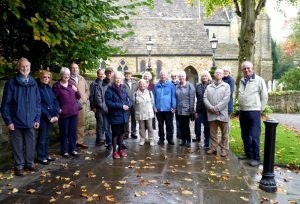On a blustery October morning around 20 members of Ferring Conservation Group met at Horsham Museum for a guided tour to discover some of the hidden secrets of this historic town with our guide for the day, Patricia Hall. This walk followed the trail in the book written and beautifully illustrated by Patricia about Horsham, entitled ‘Armchair Walks in Sussex’.
Patricia began by explaining that the name Horsham comes from ‘Horse Meadow’; a place where horses, cattle and sheep could graze in clearings in the forest.
The impressive Town Hall was our first stop and Patricia captured our imaginations as she described a scene from Elizabethan times when the ground floor was an open arcade and various stalls selling poultry, butter and such like produce was known as the ‘Market House’. The upper floor was where the County Court sat. The ten small ‘holding’ cells in the basement still exist although their windows are now bricked up. The Market House was rebuilt in 1812 by the Duke of Norfolk and his coat of arms can be seen on the front wall.
As we turned into the entrance of Pump Alley, one of several narrow alleyways, we noticed the hinged, wooden letter box on the wall at the site of Horsham’s first Post Office. It was here that letters could be handed directly to the postmaster who sat behind.
We retraced our steps and turned into a pretty road called ‘Causeway’, Patricia pointed out a wall plaque on number 8 Causeway which commemorates the War Hospital Supply Depot. This was established in 1915, during the First World War, to collect materials for hospital use to send to war zones in Europe.
Jane Hayman from the Group said “As we strode along Patricia encouraged us to turn our attention to the skyline and note the many diverse styles of architecture which makes this lovely town so special. We were also made aware of the many houses in the Causeway that employ large slabs of sandstone in their roofs extracted locally and known as Horsham Stone or Slates’.
The Museum is not only a beautiful medieval timber-framed building but also houses many fascinating artefacts. The Blazing Saddles room at the rear displayed a variety of bicycles, an old fire engine and also the unique ‘Pentacycle’, invented by a Horsham business man but unfortunately it was not a success. Crime and Punishment is the theme to another of the exhibitions, displaying keys, handcuffs and truncheons from the County Gaol which was demolished in 1845. As we turned into Morth Gardens we noticed the pretty cottages and then turned right into Denne Road and pass Drill Hall and the Lychgate to Denne Road Cemetery on our way to St Mary’s Church. The tall church spire is 156 feet high (nearly 48 metres) and has over 50,000 shingles (wooden tiles) as these are lighter than traditional tiles.
Once again we retraced our steps and headed along the Causeway back to the Museum and completed our walk at our starting point. As we thanked Patricia for a very enjoyable and informative walk, we all agreed that Horsham is indeed a lovely town with considerable historic interest.
